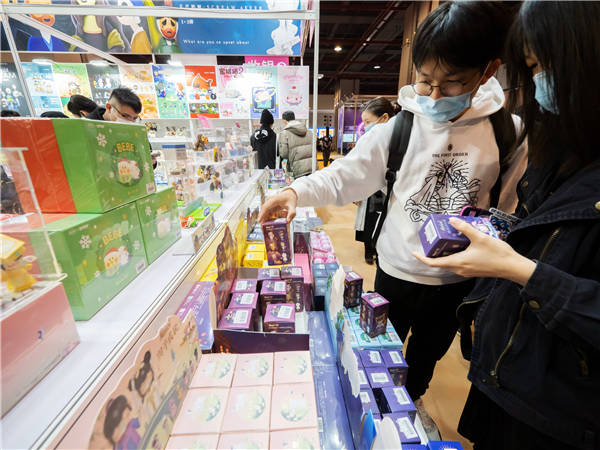




- BRNN
- BRI News
- BRNN News
- Database
Official Documents Polices and Regulations
Inter-government Documents International Cooperation BRI Countries
Business Guide Economic Data BRI Data
Trade
Investment Projects Latest projects
Cases - Content Pool

A young woman in traditional Chinese clothing Hanfu tours on a boat in Xixi Wetland in Hangzhou, capital of east China's Zhejiang Province. (Xinhua/Weng Xinyang)
In this rapidly evolving internet era, new consumption scenarios and new forms and models of business are constantly emerging, dramatically reshaping consumption concepts, preferences, and behaviors of young consumers, the main force in today's consumption market. These features are nurturing new consumption trends and generating new business opportunities.
"Here, I can stargaze at night, enjoy barbecue around a campfire, and truly immerse myself in local life," said 22-year-old Zhang Zuyang, who chose to stay in a local Kazakh residence instead of a hotel during his trip in northwest China's Xinjiang Uygur Autonomous Region.
"Sure, it's not cheap, but the experience is worth it. I want to see the world, but not go sightseeing hurriedly. I prefer this kind of immersive tourism," Zhang added.
Compared with other age groups, young consumers are more sensitive to quality of life, cultural atmosphere, and environmental ambience, showing a strong preference for experiential consumption. From outdoor adventures to exploring intangible cultural heritage, in-depth and personalized travel experiences have become the top choice of young consumers.
The 2024 Chinese Youth Consumption Trends report reveals that over 70 percent of respondents travel at least once annually, among whom, 46.36 percent arrange multiple trips per year. Exploring nature, visiting historical sites, and relaxing at resorts have become popular types of travel among young people.
Experiential consumption has boosted the popularity of ice and snow tourism, said Li Jiwei, executive director of Meituan Research Institute. Data shows that since the start of winter, searches for ice and snow tourism activities like skiing and ice skating have more than doubled. In tourist cities, accommodation, dining, and transportation are no longer just supporting services but integral parts of the travel experience. The continuous innovation of experiential consumption models is unlocking greater consumption potential.
According to Huang Jun, a professor from the School of Applied Economics at Renmin University of China, as savvy internet users, young people with broad horizons and a strong curiosity seek experiential consumption, which brings novelty and excitement, adds fun to life, and enriches personal experiences. In addition, young people who are eager to express their unique personalities find that experiential consumption provides distinctive experiences, satisfying their needs for self-expression and identity recognition while creating emotional resonance.
According to a report from the China Association of Performing Arts, nationwide revenue from commercial performances (excluding entertainment venue performances) reached 57.95 billion yuan (about $7.95 billion) in 2024. Young people are the main consumers of concerts and music festivals.
Sales data from 2024's "Double 11" shopping festival revealed that young consumers now prioritize products such as travel gear and concert tickets, shifting their focus from "whatever is cheap" to "whatever I like." Self-indulgent consumption has become a major trend among young consumers.

Visitors look at mystery boxes at the Elefun Pop Art and Toy Show held at Nan Fung International Convention and Exhibition Center in Guangzhou, Guangdong Province. (Photo/China Daily)
What is self-indulgent consumption? Simply put, it means making purchases that bring personal satisfaction. It involves spending money on things that provide emotional and psychological fulfillment, rather than just material goods. This shift reflects broader social progress—people are no longer just striving for material wealth but also prioritizing their emotional well-being and happiness.
"As living standards rise and consumption upgrades, self-indulgent consumption and emotional consumption have enormous growth potential. From purchasing anime and gaming merchandise to seeking novel entertainment experiences, young people's pursuit of happiness will continue to create consumption hotspots," Li said.
"Save where you can, spend where you should" is a common mantra among young people. They love comparing prices online, hunting for second-hand goods or affordable alternatives. However, they don't just seek the cheapest options but aim for a balance between price and quality, prioritizing "quality-to-price ratio."
Ke Ying, a post-90s young mother, noticed price differences for the same products between retail and wholesale e-commerce platforms. "Children's toys lose their appeal after a while, so I need to buy new ones frequently. I won't spend too much on them," she said. Given the same origin, factory, craftsmanship, and materials, Ke opts for the more cost-effective choice.
A report by the School of Journalism and Communication at Renmin University of China, titled "The APP Generation: Mobile App Behavior of Chinese Youth," reveals that as young people transition from academia to society, their consumption habits shift toward more practical and rational choices.
Because young consumers enjoy researching and comparing prices before buying, and sharing reviews and experiences afterward, many companies focus on targeting small groups of seed users on social media when promoting new products, gradually expanding their brand influence.

Tel:86-10-65363107, 86-10-65368220, 86-10-65363106